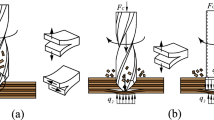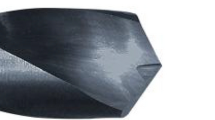Abstract
Delamination, an inter-ply debonding failure phenomenon, is considered as the most undesirable and challenging failure mode in hole making of carbon fiber-reinforced plastic (CFRP) composite laminates. The existence of delamination, even small ones, noticeably damages the strength and stability of the assembled products. It is reported that delamination is responsible for up to 60% of composite components’ rejection during assembling. In order to reduce delamination, rotary ultrasonic machining (RUM) has been studied and utilized in hole making of CFRP composites. Existing investigations on delamination of CFRP composites in RUM hole making are experimental studies, in which several methods (such as adjusting input variables and the use of supportive plate) to reduce delamination are reported. To understand delamination generation mechanisms and predict delamination initiation, theoretical investigations are needed. Cutting force models in RUM of CFRP composites have been developed, and it is well accepted that delamination is correlated to thrust force. However, there are no reported investigations to predict delamination initiation and study the impact of thrust force on the delamination of CFRP composites in the RUM hole-making process. Finite element analysis (FEA) could be an effective way to study the delamination in the RUM process. In this paper, FEA was conducted to predict delamination initiation and establish the relationship between the thrust force and delamination thickness in RUM, for the first time. In addition, experiments were conducted to validate the FEA model. The proposed model was proved to be effective in predicting delamination initiation, and the trends of the FEA results agreed well with those of the experimental results.













Similar content being viewed by others
References
Wang G-D, Melly SK, Li N (2018) Using dampers to mitigate thrust forces during carbon-fibre reinforced polymer drilling: experimental and finite element evaluation. J Reinf Plast Compos 37(1):60–74. https://doi.org/10.1177/0731684417734396
Geng D, Liu Y, Shao Z, Lu Z, Cai J, Li X et al (2019) Delamination formation, evaluation and suppression during drilling of composite laminates: a review. Compos Struct 216:168–186. https://doi.org/10.1016/j.compstruct.2019.02.099
Zou P, Li Y, Zhang KF, Liu P, Zhong H (2017) Mode I delamination mechanism analysis on CFRP interference-fit during the installation process. Mater Des 116:268–277. https://doi.org/10.1016/j.matdes.2016.11.063
Zhao LB, Gong Y, Zhang JY, Chen YL, Fei BJ (2014) Simulation of delamination growth in multidirectional laminates under mode I and mixed mode I/II loadings using cohesive elements. Compos Struct 116:509–522. https://doi.org/10.1016/j.compstruct.2014.05.042
Chen JF, Morozov EV, Shankar K (2014) Simulating progressive failure of composite laminates including in-ply and delamination damage effects. Composites Part a-Applied Science and Manufacturing 61:185–200. https://doi.org/10.1016/j.compositesa.2014.02.013
Khashaba UA (2004) Delamination in drilling GFR-thermoset composites. Compos Struct 63(3-4):313–327. https://doi.org/10.1016/S0263-8223(03)00180-6
Isbilir O, Ghassemieh E (2012) Finite element analysis of drilling of carbon fibre reinforced composites. Appl Compos Mater 19(3-4):637–656. https://doi.org/10.1007/s10443-011-9224-9
Svensson D (2015) On cohesive modelling of carbon/epoxy composites-delamination and fibre compressive failure. Chalmers University of Technology, Göteborg Retrieved from https://core.ac.uk/display/70611767
Liu DF, Tang YJ, Cong WL (2012) A review of mechanical drilling for composite laminates. Compos Struct 94(4):1265–1279. https://doi.org/10.1016/j.compstruct.2011.11.024
Tsao CC (2008) Prediction of thrust force of step drill in drilling composite material by Taguchi method and radial basis function network. Int J Adv Manuf Technol 36(1-2):11–18. https://doi.org/10.1007/s00170-006-0808-8
Wang H, Ning F, Li Y, Hu Y, Cong W (2019) Scratching-induced surface characteristics and material removal mechanisms in rotary ultrasonic surface machining of CFRP. Ultrasonics 97:19–28. https://doi.org/10.1016/j.ultras.2019.04.004
Li, Z. C., Pei, Z. J., Sisco, T., Micale, A. C., & Treadwell, C. (2007). Experimental study on rotary ultrasonic machining of graphite/epoxy panel. In Proceedings - ASPE Spring Topical Meeting on Vibration Assisted Machining Technology, ASPE 2007, 40 (pp.52-57)
Cong WL, Pei ZJ, Feng Q, Deines TW, Treadwell C (2012) Rotary ultrasonic machining of CFRP: a comparison with twist drilling. J Reinf Plast Compos 31(5):313–321. https://doi.org/10.1177/0731684411427419
Geng D, Liu Y, Shao Z, Zhang M, Jiang X, Zhang D (2020) Delamination formation and suppression during rotary ultrasonic elliptical machining of CFRP. Compos Part B 183:107698. https://doi.org/10.1016/j.compositesb.2019.107698
Cong WL, Pei ZJ, Treadwell C (2014) Preliminary study on rotary ultrasonic machining of CFRP/Ti stacks. Ultrasonics 54(6):1594–1602. https://doi.org/10.1016/j.ultras.2014.03.012
Geng DX, Zhang DY, Xu YG, He FT, Liu FQ (2014) Comparison of drill wear mechanism between rotary ultrasonic elliptical machining and conventional drilling of CFRP. J Reinf Plast Compos 33(9):797–809. https://doi.org/10.1177/0731684413518619
Ning FD, Cong WL, Pei ZJ, Treadwell C (2016) Rotary ultrasonic machining of CFRP: a comparison with grinding. Ultrasonics 66:125–132. https://doi.org/10.1016/j.ultras.2015.11.002
Cong WL, Pei ZJ, Deines TW, Srivastava A, Riley L, Treadwell C (2012) Rotary ultrasonic machining of CFRP composites: a study on power consumption. Ultrasonics 52(8):1030–1037. https://doi.org/10.1016/j.ultras.2012.08.007
Fernando, P. K. S. C., Pei, Z., Zhang, M. P., & Song, X. (2016). Rotary ultrasonic drilling of CFRP: effect of process parameters on delamination. In ASME 2016 11th International Manufacturing Science and Engineering Conference, (pp.V001T002A017). Blacksburg. American Society of Mechanical Engineers. Doi: https://doi.org/10.1115/MSEC2016-8611
Fernando, P. K. S. C., Zhang, M., Pei, Z., & Cong, W. (2017)Rotary ultrasonic machining: effects of tool end angle on delamination of CFRP drilling. In ASME 2017 12th International Manufacturing Science and Engineering Conference collocated with the JSME/ASME 2017 6th International Conference on Materials and Processing, Volume 1: Processes (pp.V001T002A015). Los Angeles, California, USA. American Society of Mechanical Engineers. Doi: https://doi.org/10.1115/msec2017-2863
Cong WL, Pei ZJ, Sun X, Zhang CL (2014) Rotary ultrasonic machining of CFRP: a mechanistic predictive model for cutting force. Ultrasonics 54(2):663–675. https://doi.org/10.1016/j.ultras.2013.09.005
Wang H, Pei ZJ, Cong W (2020) A feeding-directional cutting force model for end surface grinding of CFRP composites using rotary ultrasonic machining with elliptical ultrasonic vibration. Int J Mach Tools Manuf 152:103540. https://doi.org/10.1016/j.ijmachtools.2020.103540
Wang H, Pei ZJ, Cong W (2020) A mechanistic cutting force model based on ductile and brittle fracture material removal modes for edge surface grinding of CFRP composites using rotary ultrasonic machining. Int J Mech Sci 176:105551. https://doi.org/10.1016/j.ijmecsci.2020.105551
Wang H, Zhang D, Li Y, Cong W (2020) The effects of elliptical ultrasonic vibration in surface machining of CFRP composites using rotary ultrasonic machining. Int J Adv Manuf Technol 106(11):5527–5538. https://doi.org/10.1007/s00170-020-04976-w
Davim JP, Reis P (2003) Study of delamination in drilling carbon fiber reinforced plastics (CFRP) using design experiments. Compos Struct 59(4):481–487. https://doi.org/10.1016/S0263-8223(02)00257-X
Durão LMP, Tavares JMRS, de Albuquerque VHC, Gonçalves DJS (2013) Damage evaluation of drilled carbon/epoxy laminates based on area assessment methods. Compos Struct 96:576–583. https://doi.org/10.1016/j.compstruct.2012.08.003
Qi ZC, Zhang KF, Li Y, Liu SN, Cheng H (2014) Critical thrust force predicting modeling for delamination-free drilling of metal-FRP stacks. Compos Struct 107:604–609. https://doi.org/10.1016/j.compstruct.2013.07.036
Geng DX, Lu ZH, Yao G, Liu JJ, Li Z, Zhang DY (2017) Cutting temperature and resulting influence on machining performance in rotary ultrasonic elliptical machining of thick CFRP. Int J Mach Tool Manu 123:160–170. https://doi.org/10.1016/j.ijmachtools.2017.08.008
Phadnis VA, Makhdum F, Roy A, Silberschmidt VV (2013) Drilling in carbon/epoxy composites: experimental investigations and finite element implementation. Compos A: Appl Sci Manuf 47:41–51. https://doi.org/10.1016/j.compositesa.2012.11.020
Isbilir O, Ghassemieh E (2013) Numerical investigation of the effects of drill geometry on drilling induced delamination of carbon fiber reinforced composites. Compos Struct 105:126–133. https://doi.org/10.1016/j.compstruct.2013.04.026
Feito N, Lopez-Puente J, Santiuste C, Miguelez MH (2014) Numerical prediction of delamination in CFRP drilling. Compos Struct 108:677–683. https://doi.org/10.1016/j.compstruct.2013.10.014
Phadnis VA, Roy A, Silberschmidt VV (2013) A finite element model of ultrasonically assisted drilling in carbon/epoxy composites. Procedia Cirp 141–146. https://doi.org/10.1016/j.procir.2013.06.079
Allix O, Ladeveze P (1992) Interlaminar interface modeling for the prediction of delamination. Compos Struct 22(4):235–242. https://doi.org/10.1016/0263-8223(92)90060-P
Coelho AMG (2016) Finite element guidelines for simulation of delamination dominated failures in composite materials validated by case studies. Arch Computat Methods Eng 23(2):363–388. https://doi.org/10.1007/s11831-015-9144-1
Higuchi R, Okabe T, Nagashima T (2017) Numerical simulation of progressive damage and failure in composite laminates using XFEM/CZM coupled approach. Compos A: Appl Sci Manuf 95:197–207. https://doi.org/10.1016/j.compositesa.2016.12.026
Kaw AK (2005) Mechanics of composite materials. CRC press, Boca Raton
Park K, Paulino GH (2011) Cohesive zone models: a critical review of traction-separation relationships across fracture surfaces. Appl Mech Rev 64(6):60802. https://doi.org/10.1115/1.4023110
Song, K., Dávila, C. G., & Rose, C. A. (2008). Guidelines and parameter selection for the simulation of progressive delamination. Paper presented at the 2008 ABAQUS user’s conference, Newport, RI, United States
Barbero EJ (2013) Finite element analysis of composite materials using Abaqus™. CRC press, Boca Raton
Isbilir O, Ghassemieh E (2014) Three-dimensional numerical modelling of drilling of carbon fiber-reinforced plastic composites. J Compos Mater 48(10):1209–1219. https://doi.org/10.1177/0021998313484947
Nairn JA, Hu S (1992) The initiation and growth of delaminations induced by matrix microcracks in laminated composites. Int J Fract 57(1):1–24. https://doi.org/10.1007/Bf00013005
Topac OT, Gozluklu B, Gurses E, Coker D (2017) Experimental and computational study of the damage process in CFRP composite beams under low-velocity impact. Compos A: Appl Sci Manuf 92:167–182. https://doi.org/10.1016/j.compositesa.2016.06.023
Makhdum F, Phadnis VA, Roy A, Silberschmidt VV (2014) Effect of ultrasonically-assisted drilling on carbon-fibre-reinforced plastics. J Sound Vib 333(23):5939–5952. https://doi.org/10.1016/j.jsv.2014.05.042
Kabir MH, Fawzia S, Chan THT, Gamage JCPH, Bai JB (2016) Experimental and numerical investigation of the behaviour of CFRP strengthened CHS beams subjected to bending. Eng Struct 113:160–173. https://doi.org/10.1016/j.engstruct.2016.01.047
Selamet, S., & Garlock, M. (2010Guidelines for modeling three dimensional structural connection models using finite element methods. In International Symposium: Steel Structures: Culture & Sustainability, Istanbul, Turkey
Wang H, Hu YB, Cong WL, Hu ZL (2019) A mechanistic model on feeding-directional cutting force in surface grinding of CFRP composites using rotary ultrasonic machining with horizontal ultrasonic vibration. Int J Mech Sci 155:450–460. https://doi.org/10.1016/j.ijmecsci.2019.03.009
Chen, X., Wang, H., Hu, Y., Zhang, D., Cong, W., & Burks, A. R. (2019, June 10–14)Rotary ultrasonic machining of CFRP composites: effects of machining variables on workpiece delamination. In ASME 2019 14th International Manufacturing Science and Engineering Conference, Volume 2: Processes; Materials (pp.V002T003A051). Erie, Pennsylvania, USA. Doi: https://doi.org/10.1115/MSEC2019-3019
Acknowledgments
The work was supported by U.S. National Science Foundation through award CMMI-1538381.
Author information
Authors and Affiliations
Corresponding author
Additional information
Publisher’s note
Springer Nature remains neutral with regard to jurisdictional claims in published maps and institutional affiliations.
Rights and permissions
About this article
Cite this article
Zhang, D., Wang, H., Burks, A.R. et al. Delamination in rotary ultrasonic machining of CFRP composites: finite element analysis and experimental implementation. Int J Adv Manuf Technol 107, 3847–3858 (2020). https://doi.org/10.1007/s00170-020-05310-0
Received:
Accepted:
Published:
Issue Date:
DOI: https://doi.org/10.1007/s00170-020-05310-0




